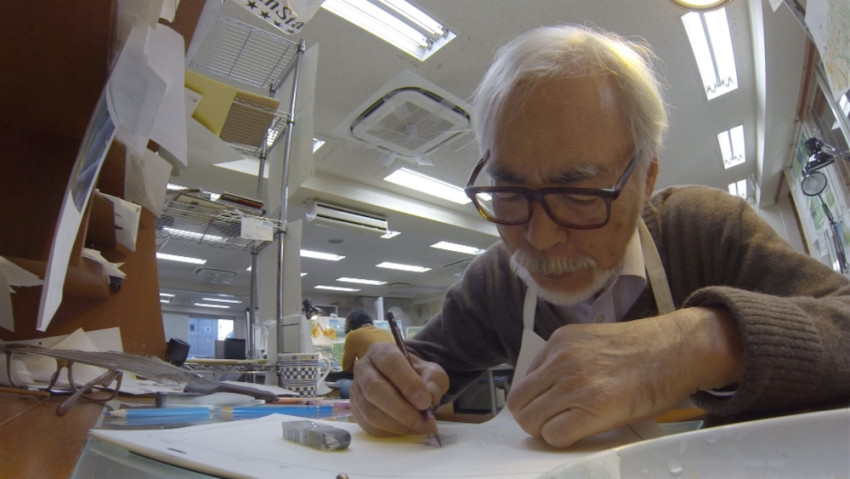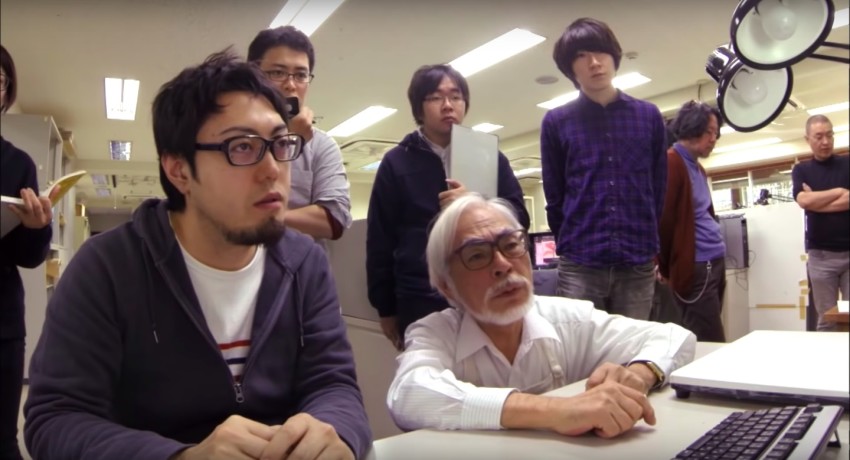Never-Ending Man
March 3, 2020 · 0 comments
By Andrew Osmond.
 Never-Ending Man is a live-action documentary film about Hayao Miyazaki, and it starts with his “retirement” announcement in September 2013, after his “final” film, The Wind Rises. Those quote marks suggest how well he stuck to his word. “I’ve caused quite a stir before by saying I’m quitting,” Miyazaki said, “so people don’t believe me. But this time, I mean it.”
Never-Ending Man is a live-action documentary film about Hayao Miyazaki, and it starts with his “retirement” announcement in September 2013, after his “final” film, The Wind Rises. Those quote marks suggest how well he stuck to his word. “I’ve caused quite a stir before by saying I’m quitting,” Miyazaki said, “so people don’t believe me. But this time, I mean it.”
For heaven’s sake, never, ever believe him. “All old directors say they’d rather make films than do anything else,” Miyazaki remarks in Never-Ending Man. “But I don’t want to make to make crap. I want to go somewhere new.”
Never-Ending Man covers a two-year period, from 2015 into 2016, in which we see Miyazaki going about his theoretical retirement. Funnily, that involves him coming into Ghibli every day and working very hard, even as he insists he’s just messing around. Most of the documentary is about his efforts to make a short ten-minute film, Boro the Caterpillar, and trying to realise his vision with CG animators. The last part of the documentary shows him deciding to make something else, something bigger, but we’ll get to that.
If you’ve seen the documentary The Kingdom of Dreams and Madness, which showed Miyazaki making Wind Rises and ended with his, ahem, resignation, then Never-Ending Man feels like the sequel. It has a different director, though, Kaku Arakawa; Dreams and Madness was directed by Mami Sunada.
 But Never-Ending Man has its own arc, partly defined by the Boro project and Miyazaki’s efforts to bend the tools and algorithms of CG to create a fleshy, undulating caterpillar. More fundamentally, this is a Portrait of the Artist as an Old Man, well aware he’s only getting older. Miyazaki turns 74 at the start of this film; he’s 79 now.
But Never-Ending Man has its own arc, partly defined by the Boro project and Miyazaki’s efforts to bend the tools and algorithms of CG to create a fleshy, undulating caterpillar. More fundamentally, this is a Portrait of the Artist as an Old Man, well aware he’s only getting older. Miyazaki turns 74 at the start of this film; he’s 79 now.
After the retirement announcement, the film cuts to 16 months later, and a snowfall outside the windows of Miyazaki’s “Aetelier Nibaraki” building near Ghibli. “Lots of snow,” Arakawa remarks. The documentarian is never seen on screen, like Sunada in Dreams and Madness. The self-effacement feels respectful to Miyazaki, though Western viewers may hanker for a When Louis (Theroux) Met Hayao. “Lots of funerals, too, lately,” Miyazaki replies. “I hate it. They were all younger than me.” Later, he’s blunter. “People are dying who should have outlived me.”
Winter has come for Miyazaki. Mortality and ageing pervade the film. We see Miyazaki’s response to two deaths, that of Masako Shinohara, who’d worked with him for a half a century, and colour designer Michiyo Yasuda. (The film ends before the passing of Isao Takahata in 2018.) But it’s not just deaths; even “young” acquaintances are getting old. Producer Toshio Suzuki is seven years Hayao’s junior, but we see him mention that his doctor told him to restrict his driving to an hour a day.
Miyazaki himself says his focus has gone. “If I concentrate like I once did, I suddenly get exhausted. I just fool around now.” Miyazaki has said such things for decades. Back in my 2008 Spirited Away book, I wrote, “Miyazaki’s well-publicised ailments – failing eyesight, inflamed finger-joints, his constant complaints of falling energy – are part of his public persona, a morbid barometer of his career.”
The film constantly reminds us that Miyazaki’s words must come true in the end… but not yet. More than once, we see the much younger Boro staff looking at the work that this old geezer is producing, stunned by the detail. We see the work, too, and they’re not just being polite.
The film also shows Miyazaki grappling with CG technology. Of course it’s figured in his films since Mononoke, but he hopes to take far greater advantage of it here. We see him enthused and excited by the earliest tests, then frustrated as the CG animators can’t make Boro move and live as he wants.
 Most of today’s anime studios and film-makers find balances between CG and hand-drawn techniques that satisfy them; see our recent articles on Promare and Weathering with You. You might extend that to a Hollywood director like Scorsese, almost the same age as Miyazaki, who accepted the imperfect overlay of CG in The Irishman as a way to “de-age” his top actors. Miyazaki is harder to please.
Most of today’s anime studios and film-makers find balances between CG and hand-drawn techniques that satisfy them; see our recent articles on Promare and Weathering with You. You might extend that to a Hollywood director like Scorsese, almost the same age as Miyazaki, who accepted the imperfect overlay of CG in The Irishman as a way to “de-age” his top actors. Miyazaki is harder to please.
Although it’s not brought up in the film, Boro is something of a return to Nausicaa, Miyazaki’s opus of nearly 40 years ago, set in another world of bugs. That had giant creatures very like caterpillars, called Ohmu. In the Nausicaa film, the Ohmu’s segmented bodies were animated through extreme analogue means, by using overlapping pieces of card (presumably traced). In the manga, Miyazaki drew hundreds of Ohmu himself, using that cutting-edge triumph of tech, the pencil.
Obviously, Miyazaki didn’t need CG animators to realise an insect world. He’d already directed a bug-based short for the Ghibli museum, 2006’s Monmon The Water Spider (you can see clips here, 50 seconds in). Even nine years later, Miyazaki could surely have found enough traditional animators to draw ten minutes of Boro and his environment. Midway through Never-Ending Man, one of the CG artists looks at the drawings Miyazaki is making as guides (!), and confesses it might be faster to just draw the animation by hand. “I can’t draw a caterpillar with a pencil,” Miyazaki claims in a film which shows him doing just that, umpteen times over.
For that matter, Miyazaki didn’t even need animation to continue creating. Some fans, myself included, think his greatest work is in manga form. Miyazaki’s comments suggest he was drawn to CG precisely because it was (largely) new to him; and perhaps because younger animators were migrating there too. “Hayao likes young people,” Suzuki claims in the film. “They energise him. But what happens to the young people? Working with him ages them.”
 That’s brutally demonstrated in one of the film’s most memorable scenes, which you may have already seen excerpted online. It’s when CG animators from another company turn up to show Miyazaki movement generated by A.I. Unfortunately, what’s been generated is a zombie creature whose flailing undulations parody what the director sought in Boro. Miyazaki’s response is to royally bollock the programmers; his outburst makes Alan Sugar on The Apprentice look like a cuddly Totoro.
That’s brutally demonstrated in one of the film’s most memorable scenes, which you may have already seen excerpted online. It’s when CG animators from another company turn up to show Miyazaki movement generated by A.I. Unfortunately, what’s been generated is a zombie creature whose flailing undulations parody what the director sought in Boro. Miyazaki’s response is to royally bollock the programmers; his outburst makes Alan Sugar on The Apprentice look like a cuddly Totoro.
There are other glimpses of the curmudgeonly Miyazaki, including an annoyed swipe at a certain Disney anthem of the 2010s. “It’s all about being yourself. But that’s terrible… Self-satisfied people are boring.” Later, Miyazaki mentions that some of his staff are going to see the latest Star Wars film. “They’ll all be bowled over and want to do Star Wars, not a caterpillar,” grumbles the director who made that modest slice of life film, Princess Mononoke.
Rather annoyingly, the film leaves the caterpillar story unfinished. We don’t see Boro completed; the film indicates that Miyazaki decides to use more hand-drawing, and his own animation at the end looks extremely like imagery from Nausicaa. However, Anime News Network reports that Boro’s caterpillars were still animated entirely in CG. The film debuted in March 2018 in the Ghibli Museum, which is the only venue that shows it; I haven’t seen it.
Instead, the last scenes of Never-Ending Man show Miyazaki, after all his troubles and frustrations with Boro…going up to Suzuki and saying he wants to make another feature film. Suzuki asks what if Miyazaki dies right after finishing the storyboards; it goes unanswered. Miyazaki’s plan is to finish the film in three years, before the Olympics. It looks as quaint now as George R.R. Martin saying he could end his Game of Thrones books before the TV version caught up.
The name of Miyazaki’s film isn’t mentioned in the documentary. Some reports wrongly claimed it was a feature-length expansion of Boro the Caterpillar. In 2017 the feature’s title was announced as How Do You Live?, homaging a 1937 Japanese novel of the same name. In Suzuki’s book Mixing Work With Pleasure (specifically in a preface written in 2017 for the English-language edition), the producer describes the new film as “fantasy on a grand scale.” Little more was heard until December 2019, when Suzuki appeared on another Japanese documentary. He said that after three and a half years work, Miyazaki had finished 15% of the film, and was working at a rate of a minute a month.
For some fans, that’s enough to make them give up any hope of seeing the film finished, at least in Miyazaki’s lifetime. Yet Never-Ending Man offers grounds for hope. It shows how Boro was also moving at a hopelessly sluggish pace, until the problems to be fixed, the barriers broken. Or as Miyazaki shouts, “Let’s break out of this! We’ve been constipated too long!”
And the future of Ghibli? In Never-Ending Man, Suzuki takes the line it means nothing without Miyazaki. “If Hayao quits, it’s meaningless to have a production team.” There’s no hope of finding an heir. “I ate them all,” Miyazaki confesses; the line is cheekily juxtaposed with a glimpse of the all-devouring No-Face in Spirited Away.
Yet that’s before Miyazaki embarks on How Do You Live? By 2017, Suzuki was talking of Ghibli’s “mission” to continue making films. He was also announcing a new CG feature by Miyazaki’s most contentious heir, his son Goro. (This film’s current status is unclear.)
Miyazaki is frank about how he may not finish his own feature before it finishes him. “I’m prepared to die before it’s finished. I’d rather die that way than die doing nothing. To die with something to live for.” If that sounds too morbid, you might append comments that Miyazaki wrote decades ago, for a high-flying heroine in his manga Nausicaa. “I can hear a voice in my heart, all the time. Go forward, it tells me. So all I think of now is going forward, as far as I am able.”
Never-Ending Man is released in the UK by Anime Limited.
Leave a Reply